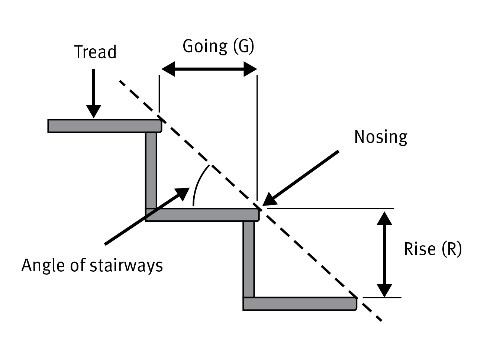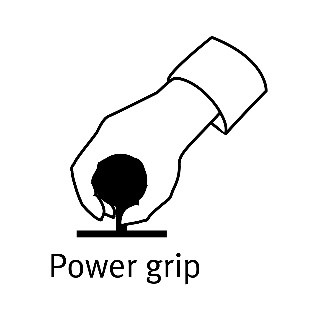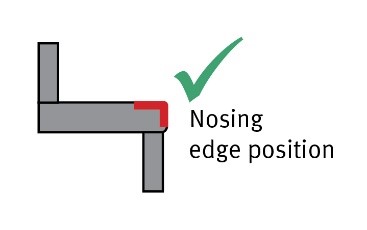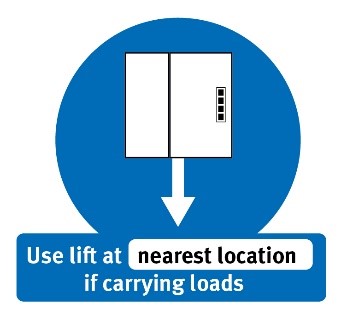Utilize this information provided by WorkCover Queensland to minimize incidents of falls on stairs and steps in your workplace.
In your specific circumstances, it is crucial to refer to the relevant building codes and standards, as this risk management guidance does not serve as a replacement.
Consider the following design requirements for stairs and steps:
Ensure uniform dimensions for all risers and goings on the same flight of stairs within a tolerance of ±5 mm.

Riser and going dimensions
| Rise (R) | Going (G) | Slope relationship (2R + G) | ||||
|---|---|---|---|---|---|---|
| Range (mm) | Min | Max | Min | Max | Min | Max |
| AS1657 | 130 | 225 | 215 | 355 | 540 | 700 |
For optimal safety while using stairs at your workplace, WorkCover Queensland recommends the following guidelines:
- Ensure that the tread of each step covers the entire width of the stairway.
- Choose a slip-resistant surface for the tread to prevent accidents.
- Make sure the nosing or edge of each step is slip-resistant, well-maintained, and easily visible in all lighting conditions.
In terms of the angle of stairways, aim for an inclination between 20 and 45 degrees to the horizontal tread. WorkCover Queensland suggests a recommended angle ranging from 30 to 38 degrees.
Consider the following specifications for flights and landings:
- Each flight should consist of a minimum of two risers and a maximum of 18 risers.
- Connect adjacent flights with a landing.
- Ensure that stairway landings are at least as wide as the stairway itself.
- Provide a standing space of at least 600 mm, ensuring it is clear from cross-traffic, door swings, or any other structures.
For addressing common hazards associated with stairs, WorkCover Queensland emphasizes the importance of addressing isolated, short, and irregular steps:
- Isolated steps, which are not clearly visible, should be removed where possible. Alternatively, highlight them with slip-resistant nosing in a different pattern or color and consider adding a handrail.
- Short steps that lack adequate support for the foot should be fixed, and slip-resistant nosing in a distinctive pattern or color can be added for visibility.
- Irregular steps, whether longer or shorter than others in a flight, should be rectified. Highlight them with slip-resistant nosing and ensure handrails are provided.
To identify irregular steps, WorkCover Queensland recommends marking and checking for inconsistencies in dimensions. Mark step rises on a sheet of A4 paper starting from the bottom step and compare them to detect any differences. If variations are noticed, measure the rises and goings with a ruler.

In the context of workplace safety, WorkCover Queensland emphasizes the significance of handrails as essential support when navigating stairs. It is crucial that handrails are easily gripped to provide support in case of balance loss.
For effective use, each stairway should be equipped with at least one handrail. In cases where stairways exceed a width of 1000mm, WorkCover Queensland recommends installing a handrail on each side.
Handrails, as outlined by WorkCover Queensland, should adhere to the following criteria:
- Positioned between 900mm and 1100mm above the floor or the nosing of a stair tread, shaped to facilitate a secure 'power grip' for individuals.
- Maintain a minimum hand clearance of 50mm from adjacent structures, ensuring no sharp edges or features that could pose injury risks during use.
- Allow unrestricted continuous movement of the hand along the upper surface throughout its length, free from any obstructions on or above the handrail that might impede use.
- Visually contrast with their surroundings for easy identification.

These specifications are in accordance with Australian Standards 1657 (2018), specifically addressing the design, construction, and installation of fixed platforms, walkways, stairways, and ladders.
WorkCover Queensland emphasizes the importance of enhancing visibility and recognition of stairs, handrails, and potential hazards. This can be achieved through thoughtful considerations:

- Ensure well-distributed lighting on stairs, avoiding shadows and glare. If necessary, include local lighting at the handrail.
- Utilize contrasting materials on the nosing to prevent over/understepping and on the handrail for easy detection. These materials should offer a significant visual difference from the background.
- Evaluate the visual contrast between the tread and nosing using a black and white image of the stairs.
- Minimize distractions by refraining from placing posters, signs, or notice boards on or around stairs.
- Avoid patterned carpets that may obscure differences in depths or divert attention from the nosing.
- Opt for matte finishes on the treads to reduce glare, contributing to a safer working environment.
WorkCover Queensland advises on practical measures for a safer work environment:

- Opt for the nearest lift when carrying loads to reduce the risk of falls.
- Ensure work activities allow for a free hand to easily grab a handrail in case of a fall.
- Maintain visibility of the immediate travel path and avoid carrying objects requiring both hands.
- Consider using alternate routes, such as lifts or alternative paths, to transport items and prevent obstructions in the walking path.
- Refrain from using devices or reading while walking to stay focused on the surroundings.
Regarding housekeeping:
- Regularly inspect, clean, and maintain stairs and handrails to ensure they remain in good condition.
- Swiftly address spills, wet spots, or debris to prevent slips and falls.
- Repair any loose or protruding parts of stair surfaces and handrails promptly.
- Avoid storing items on stairs to maintain a clear and safe walking path.
- Apply slip-resistant surfacing to the tread surface and nosing, and ensure adequate contrast.
- Rectify faulty lighting to enhance visibility.
- Establish a responsive hazard reporting and maintenance program for ongoing safety.
